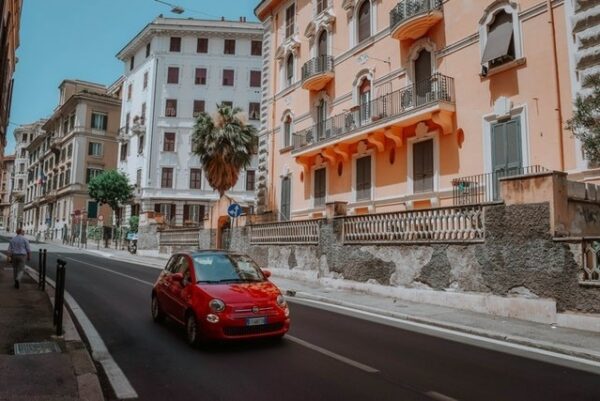
A comprehensive guide to driving in Europe

Depending on where you're going and what you're doing during a holiday in the EU, having access to a car can make your life significantly easier. You might be thinking of taking your own car or campervan with you, or you might be looking to hire a vehicle once you're there.
Either way, there are certain things you'll need to be aware of, rules you'll need to follow and documents you'll need to take to ensure that you stay on the right side of the law. To avoid problems or fines, here's what you need to know.
Which documents do I need when driving in the EU?
As a general rule, follow this checklist to ensure you have the right documents to avoid fines - and the risk of your vehicle being towed.
- Valid driving licence (check it is still in date!)
- Passport
- Travel insurance documents
- Any documentation needed to prove your COVID status (check here for a country by country guide)
Those planning on taking their own vehicle will also need:
- V5C vehicle registration certificate
- Car insurance documents
If you're planning on hiring a vehicle, it's also wise to request a DVLA licence check code, which allows car hire companies to check your driving record, before you travel. While many car hire companies won't ask for it, don't leave things to chance.
Depending on the country you're visiting and the length of time you're planning on staying, you may also need an International Driving Permit (IDP). Find out here where they're required.
Do I need any special equipment when driving in the EU?
In certain EU countries, you're required by law to carry certain equipment in your vehicle when driving. This varies from country to country, as well as from season to season.
Some countries require that you carry a first aid kit, while in others you need warning triangles and/or reflective jackets. In some EU countries, your vehicle will need to contain a fire extinguisher, and there may also be requirements for things like breathalysers, pre-purchased toll passes, winter tyres and snow chains (depending on the season). There are also certain countries where dash cams are banned.
If you're bringing your own vehicle, you'll obviously need to provide this equipment yourself. If you're hiring a car, your hire company should provide all of the necessary equipment - but it's your responsibility to double-check it's all there.
You'll find a basic equipment guide here, but check the country's rules thoroughly before setting off.
Check the driving laws
It's not just driving on the right (except in Ireland, Malta and Cyprus) that differs when driving abroad. Just as in the UK, each country has its own rules of the road.
Familiarise yourself with seatbelt requirements, speed limits and other country-specific rules before you leave. This is a good place to start.
Convert your headlights
If you're taking your own car to a country where you'll be driving on the right-hand side of the road, you'll need to purchase headlight converters. These are important, as UK headlights will dazzle drivers when you switch sides - and avoiding dazzling other drivers is a legal requirement almost everywhere in the EU.
Headlight converter kits are inexpensive. These converters are stickers that you affix to your headlights and come complete with instructions for doing so. Just remember to remove them before you start driving in the UK again.
Travelling through tolls?
Toll roads are a common sight across the EU. While many now accept credit cards, not all do - and some may prefer not to use credit cards on their holiday.
Instead, make sure you check toll road costs before you leave, and ensure, if possible, that you have plenty of change to cover the payments. It will save unnecessary stress at the time of payment.
Travelling with children?
If you're on a family holiday with children, be sure to check the requirements for car seats and seat positions in the country you're visiting.
Those planning on hiring a car abroad can hire a car seat when they arrive, but this can add significant costs to your hire price. Instead, check with your airline: many will allow you to check a car seat into the hold of the plane, in addition to your suitcases.
How have EU driving rules changed since Brexit?
There are a few ways in which driving in the EU has changed since Brexit happened.
After Brexit, the UK lost membership of the green card free circulation zone (GCFCZ). However, the European Commission reinstated the UK's membership in August 2021. This means that UK motorists do not need to produce a "green card" as proof of insurance when driving in any EU country (or Andorra, Bosnia & Herzegovina, Montenegro, Serbia and Switzerland).
The major change that Brexit has brought about for UK drivers driving in the EU is in the form of stickers. Under previous rules, UK drivers using their own car in the EU had to have a GB identifier plus the Euro symbol on the number plate. If this wasn't on the number plate, a separate GB sticker was required.
Now, the GB has been replaced with UK. Those with newer cars will have a UK identifier on their number plate already, and so won't require additional labelling. Those who still have a GB number plate, though, will need to display a UK sticker on their car when driving in EU countries.
There are a few exceptions to the rule, however. When driving in Ireland, there's no need for a UK number plate or sticker. When driving in Cyprus, Malta or Spain, a UK sticker is ALWAYS required - even with a UK number plate.
Be aware of low emission zones
Many major towns and cities throughout the EU have low or zero-emission rules in place. These will affect where and when you can drive, depending on the age and emissions of your vehicle, so check requirements before you leave.
Finally, enjoy your trip. With the right planning and research, you'll be able to drive throughout the EU with ease, whether in your own car or a hire car. Safe travels!
Article tagged with:
